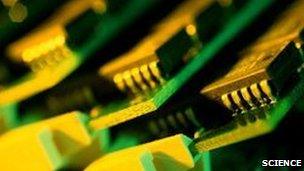Computer memory heralds green PCs
- Published

Traditionally computers rely on two distinct forms of memory technology
A new form of computing memory which could lead to faster starting, user-friendly computers has been developed by US researchers.
The device, developed by a team at North Carolina State University, claims to combine the advantages of two commons forms of memory used today.
The "unified" memory device, outlined in the journal IEEE Computer, external, is still undergoing testing.
But the team believe it could form the basis of PCs that start immediately.
Permanent speed
Currently, computers rely on two distinct forms of memory: volatile and non-volatile.
The type of memory used depends on whether data needs to be accessed quickly or stored permanently.
Volatile technologies such as random access memory (RAM) or its newer variation DRAM, store data in such a way that it can be read and written rapidly, making it ideal for rapid computations. But the data is lost when the power is switched off.
By contrast, non-volatile memory devices, such as the flash drives found in memory cards, USB dongles and MP3 players, can retain information for long periods without power.
But the device created by Dr Paul Franzon and his team combines the speed of DRAM while being able to switch to a more persistent mode of storage.
That would potentially enable computer makers to build machines that boot up almost instantly, as the information needed to start up the machine could be stored in fast memory, said Dr Franzon.
It could also lead to servers that can be powered down, when not in use.
Currently, the servers found in most data centres continue to slurp energy even when their processors are idle because the server memory cannot be turned off without affecting performance.
Lasting memory
The device developed by Dr Franzon's team - known as a double floating-gate field effect transistor - stores data in the form of a charge, like non-volatile memory but uses a special control gate to enable the stored data to be accessed quickly.
Today's flash memory devices use a single floating gate to store an electric charge, which represents data. "We realised that a second gate would allow us to transfer charges really quickly," said Dr Franzon.
His team have shown they can transfer charges - in effect change the data - in around 15 nanoseconds. "That's comparable with DRAM speeds," he added.
When in non-volatile mode, the data will be stored safely for a couple of years.
- Published24 May 2010
- Published12 November 2010